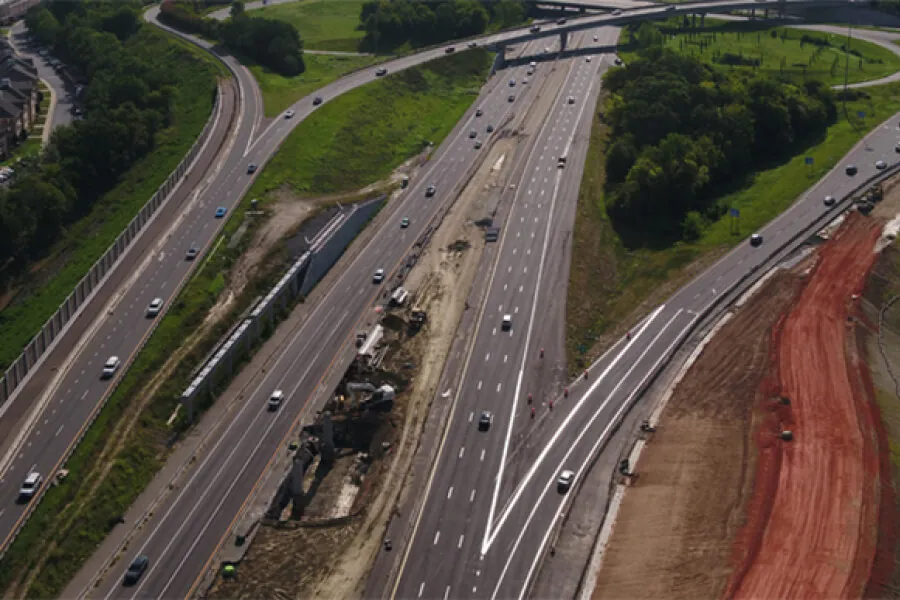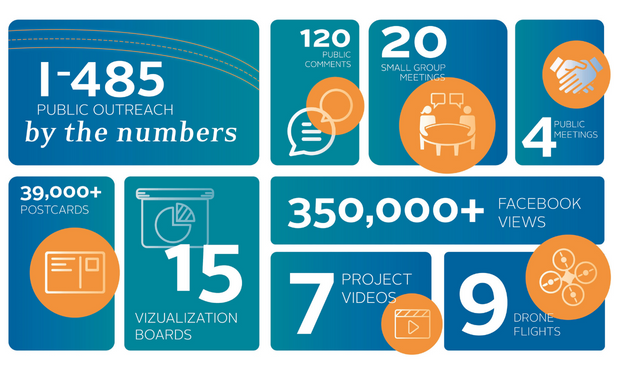RS&H Designs Concepts, Cultivates Public Involvement for I-485 in Charlotte

Charlotte, North Carolina, has been one of the fastest growing metropolitan areas in the U.S. for much of the past few decades. In fact, the population in Charlotte and Mecklenburg County is well over 1 million today, more than double that of the population 25 years ago.
With that influx of population also came an influx in traffic volume, which can still slow the major arteries leading to and from the Queen City every day. Keeping up with this level of growth requires a significant amount of planning and infrastructure.
In 2007, the North Carolina Department of Transportation (NCDOT), the City of Charlotte and other regional transportation agencies and municipalities began studying alternatives to help roads perform better without necessarily adding more general purpose lanes. The recommendation of the region-wide study was for a network of express lanes on several of Charlotte’s busiest arteries – I-77, I-485 and U.S. Highway 74 (Independence Boulevard).
The I-485 corridor project between I-77 and US 74 adds an express lane in each direction and will ultimately serve as part of a larger network of express lanes in the Charlotte region. Additionally, a general purpose lane is added in each direction between Rea Road and Providence Road near the Ballantyne neighborhood.
NCDOT tasked RS&H to design concepts, perform National Environmental Policy Act (NEPA) documentation and ultimately prepare the 17-mile project for a design-build letting.
“We were able to take the project from an idea to getting it ready for the design-build procurement,” said RS&H Vice President Radha Krishna Swayampakala, who leads business development efforts for RS&H Infrastructure in the Mid-Atlantic Division.
RS&H started work on the project in 2013 with NEPA planning and then roadway design. NCDOT and the North Carolina Turnpike Authority (NCTA) also entrusted RS&H to perform toll operations analysis and provide design support. Additionally, RS&H led public involvement efforts, traffic forecasting and traffic analysis.
Designing a New Concept for North Carolina
This was one of the first express lanes projects for the Charlotte metro area. RS&H’s national tolls, technology and managed lanes team, led by Mike Davis, brought the project team and stakeholders up to speed.
“We used our tolls team to guide us and inform NCDOT on the expectations relative to express lanes and overall operations,” Swayampakala said. “They played a key role in developing a strategy and associated education material for public and elected officials.”
In addition to determining tolling functions, RS&H designers considered different factors for the express lane project. Because the express lane is usually in the middle of the interstate, direct connectors must fly up and over existing interstate lanes to make the direct connection to the side roads.
“Interstates usually have right-hand aspects – you often veer away from the interstate horizontally before you go vertical,” said Jennifer Farino, RS&H’s roadway design lead for the project. “But when you’re in the middle of the interstate you have to get this lane, which is known for higher speeds and having a direct route to where motorists want to go, elevated to the second level to go over the interstate mainline traffic in a very confined space.
“This creates the need for vertical retaining walls to be constructed in order to bridge over the interstate lanes to connect to the side road in a direct route.”
Farino’s team was tasked to design a few different interchange concepts for each direct connector location. They laid out different scenarios for the direct connectors and worked with the traffic and planning teams to evaluate the different scenarios.
“We evaluated the direct connectors at different locations based on the constraints of existing bridges and other existing infrastructure,” Farino said. “That gave us control points to make everything fit geometrically while trying to keep environmental and human impacts to a minimum and work within the existing right-of-way.”
Because the point of an express lane is to get motorists reliably from Point A to Point B, it is not recommended to have too many disruptions from direct connectors on the route. To analyze how the proposed direct connectors will function, RS&H performed an extensive traffic operations analysis using TransModeler software.
“This was the first time this level of detailed analysis was performed for an NCDOT project,” Swayampakala said. “Using this analysis, RS&H evaluated several different locations for direct connectors and different designs for those locations, all with a goal to create the most efficient, least impactful, most functional design for I-485.”
More Resources for Public Involvement
“I am a strong believer that we need to reach out to the public as early as possible, even if we don’t have all the answers,” said Jenny Noonkester, RS&H’s public involvement lead for the project.
Over the course of public involvement, more than 20 RS&H creatives contributed over 5,000 hours to awareness efforts. The team started with print newsletters and visualization boards, posters, and automated presentations. Branding for the project created an overall look and feel for all media materials.
“We sent out over 39,000 postcards each time there was a project meeting,” said Noonkester. “We wanted to reach neighborhoods beyond the immediate project corridor because this project affects so many people.”
The public involvement team was also fast to utilize digital solutions for public input via different platforms and social channels, methods that would prove beneficial when COVID-19 stopped public in-person meetings.
“Public involvement has definitely changed since this project began,” said Amy Coons, a senior graphic designer in RS&H’s Charlotte office. “With this project, there is a push toward social media and utilizing geofencing ads to reach more and more people. We’re creating multiple videos and providing more access as well.”
These materials were also available at smaller community meetings in different neighborhoods, as project officials worked to educate the public on how I-485’s managed lanes will ultimately ease congestion in the growing metro.
Over the last several years, the RS&H team has reached out to every municipality and several neighborhoods along the corridor, extending invitations to HOAs and regularly sending out newsletters and project updates. They have met with dozens of different community and business groups.
After the design-build team was selected, RS&H continued to stay involved with the project, reviewing design and construction plans for NCDOT and NCTA. The firm has also continued its public outreach efforts during construction and chronicled the project’s progress with quarterly drone flights to capture photos and video.
Going above and beyond the requirements is a big part of why RS&H was selected for the project in the first place. I-485 is the latest of several major transportation infrastructure projects in the Carolinas RS&H has played a major role in.
There is a big reason for that.
“The biggest thing is collaboration,” Swayampakala said. “We are a true partner with NCDOT and the NCTA and with all of the project’s stakeholders, and we have done everything we can to ensure the public trust for this project.”
